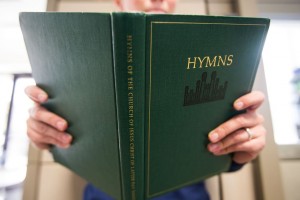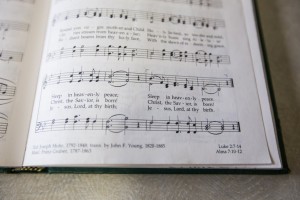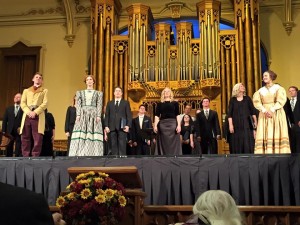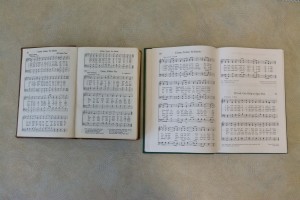
Every time BYU editing professor Marvin Gardner opens a green 1985 LDS hymnbook, he remembers the spiritual experiences he and the other seven Hymnbook Executive Committee members had 30 years ago as they selected, compiled and edited hymns for the then-new hymnbook.
Gardner learned a lot about editing during the experience. But he “learned even more about the whisperings of the Spirit,” he said.
The hymnbook turned 30 years old this September, but hymnbook contributors and other music lovers still see it as a beloved, living text they remember daily through stories, celebrations and constant interaction.
Noticing the Lord’s hand in the details
One night near the end of the hymnbook project, Gardner had finished proofreading a packet of hymns, but he had a “definite feeling that (he) had missed an error.” He didn’t know where to start looking for this one error, but as he thumbed through the hymns something told him to stop at “Silent Night.”
“We always had a spirit of prayer and a spirit of asking the Lord to help us get it right,” Gardner said. “If the Spirit was telling me there was a mistake in ‘Silent Night,’ I was going to study ‘Silent Night’ until I found the error.”

It was late. Gardner’s tired eyes couldn’t find the error. He first thought it might be a figment of his imagination, but the feeling persisted on his way out the door. He returned and re-read the hymn forward and backward. Then he found the mistake.
The end of the hymn had two lines: “Christ, the Savior, is born” and “Christ, the Savior is born.” Gardner knew they needed to be the same; one was grammatically correct, one was not.
He realized the last line looked like a direct address, as if the hymn was “informing Christ of the great news that the Savior is born,” he said. “Of course that needed to be corrected!” He felt grateful as he penned in the comma and went home knowing it would be right in the hymnbook.
Gardner tells that story to his copyediting students each semester to show his belief that the Lord cares about commas, but also to share a deeper message. “It also illustrates that the Lord is willing to help us with even the smallest details of our lives,” Gardner said.
The “Silent Night” experience wasn’t unique. Sometimes Gardner saw the Lord’s hand as he found music errors, such as a time when he found a missing flat in “See the Mighty Priesthood Gathered.”
“There were many times, like the ‘Silent Night’ experience, when the Lord helped us with the words and punctuation and music,” Gardner said. “Can you see why I felt that this was really an errand from the Lord?”
Celebrating the stories

There have been a few celebrations, similar to firesides, since 1985 in the Assembly Hall in Salt Lake City. Temple Square Performances put on more of a production this year for the 30th anniversary with actors and video interviews telling the stories of those who compiled and contributed to the different hymnbooks. A choir, which had only rehearsed twice before performing, sang the hymns.
Jared Pierce, the arranger of the hymns that were performed at the concert, said he wanted the hymnbook and its contributors, which included people from 180 years ago and people in the audience, to come to life.
The goal for each story was to let people know “that (the contributors’) efforts were coming from inspiration, and that they were dedicated to the work being right,” Pierce said.
Daniel Carter composed the music to “As Now We Take the Sacrament.” He wanted to do something different with the music when he first composed it, but it took multiple tries to get it just right. “I had to un-think the process and just let go,” Carter said. “Once I did that, all of a sudden there was a melody in my head for no reason.”
Carter wasn’t sure he wanted to attend the celebration this September. So many things had happened in his life, with so many ups and downs, that the flood of memories the celebration brought back made Carter consider not going.
But a colleague encouraged him to go. His story was one of the evening’s central stories. “I wasn’t expecting anything at all,” Carter said. “And then this guy gets up in a lavender shirt and he starts telling the story as if he was me and I thought, ‘Oh my goodness, this is real.’ I was blown away.”
The portrayal of his struggle writing and re-writing the music seven times still brought back memories, but they were of raising his kids and “all kinds of great things,” Carter said. “It was a good thing.”
Remembering the hymnbook’s effects
Hymnbook contributors still connect to the hymns they worked on. Carter calls “As Now We Take the Sacrament” his gift to the church. “When I hear it, it does make me think that despite all the things that did go wrong in my life, that was one thing that I was able to do to pay it forward,” he said.
K. Newell Dayley wrote the music to “Lord, I Would Follow Thee.” He said he feels deeply grateful and reverent every time it’s sung. “I know its true origin,” Dayley said. “Others often mention its simple elegance and deeply personal message.”
In addition to editing much of the hymnbook, Gardner wrote the text to “Press Forward, Saints.” He and many people who knew him were excited when it was the first song the Mormon Tabernacle Choir sang in the new Conference Center.
But Gardner said it’s more significant to him when people don’t mention it. “What that says to me is that people don’t think of Marv Gardner anymore when they sing that hymn,” Gardner said. “They’re thinking of the message of the hymn… And it’s taking its place as a standard hymn of the church, rather than being Marv Gardner’s new hymn.”
Expanding on the hymnbook
Pierce hoped to show the hymnbook’s life at the celebration. “This hymnal, although it’s 30 years old this year, still has so much more room for growth,” Pierce said. Translation is one important avenue for a worldwide reach.
Thy hymnbook is published in 31 different languages. Nine more are currently in the process of translation. Each translated edition includes 104 standard hymns; with an additional 50 found in most language hymnbooks.
Area presidencies can recommend, of those 50, “a few local hymns which are long-established traditions in the language,” said Diane Bastian, manager of the Church Music Division.
Although there are no current plans for a new hymnbook, the Church annually accepts submissions of original church music “to encourage musical talent and bring new musical works to light,” according to LDS.org.
Trying to choose a favorite hymn is, to Gardner, similar to trying to choose a favorite child. He said there are a lot of “undiscovered gems” people should uncover. He’s heard of people singing one of the 341 hymns each day for a year to familiarize themselves with the hymnbook.

Features in the 1985 hymnbook not in past editions include scripture references at the end of each hymn, brackets indicating which measures to play for introductions, and the “Using the Hymnbook” appendix advice on how to select hymns and direct music.
The “most precious” addition, Gardner said, is the First Presidency Preface. “It’s a great witness from the First Presidency about the importance of the hymns. The hymnbook is very unifying across nations and across generations.”
People have told Gardner how “Press Forward, Saints” has influenced their lives, whether by perfectly portraying a loved one’s life at a funeral or by helping them through hard times.
Experience has shown Gardner that hymns can be answers to prayers. He calls “Press Forward, Saints” a personal blessing. “It has been a motivation to me when I’ve been discouraged,” Gardner said. “It’s been an uplift to me when I’ve been depressed. It’s been a gentle whisper from the Lord to me to press forward and not give up.”




